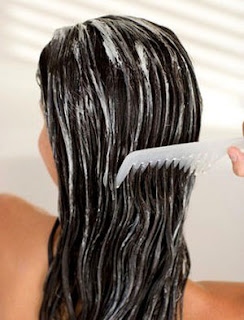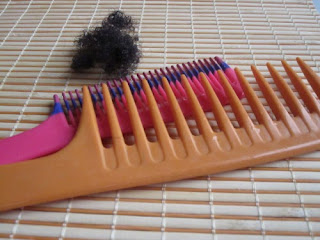
The natural hair experience can be a very exciting and interesting one. It offers much versatility and a certain level of freedom regarding its maintenance. There are, on the other hand, challenges that come with wearing your hair natural. One of the most dreaded hair processes faced, especially by naturals, is that of detangling. This can be a grueling task because natural hair is usually thicker, and in many cases, very tightly coiled. These factors make it more difficult to detangle and sadly it is the same factor that causes most natural hair to become more prone to getting tangles and knots.
There is a common misconception that natural hair is very strong and can
withstand anything that comes its way. Contrary to popular belief, natural
hair, especially if tightly coiled, is very fragile and prone to breakage.
Detangling requires manipulation of the hair and special care must be taken in
order to avoid damage to your fragile strands during this process. Vigorously
combing and brushing your hair in an attempt to remove tangles can pull on the
hair and cause extensive damage. The truth is it is extremely difficult,
if not impossible, to prevent knots and tangles from accumulating in the hair
but with proper techniques you will be able to minimize and possibly eliminate
the drama associated with detangling. Adapting the following strategies
will indeed help you to avoid the detangling woes:
1. Detangle When Wet

Water moisturizes the hair and
makes it more elastic causing it to have more slip, less friction and a looser
curl pattern. This makes it easier to remove tangles and knots. Wet hair is not
likely to break easily when a comb is repeatedly passed through it. If your
hair is matted or tangled, however, it is advised to try to remove those knots
and tangles while the hair is dry as it is stronger in its dry state. You can
then proceed to wet the hair in order to do the more detailed detangling.
2. Detangle In Sections
As a general rule, hair is more manageable when it is handled in sections. Dividing your hair into four equal sections usually makes it easier to manipulate. Those with thicker, more densely packed strands may have to use six or more sections. Once the hair is sectioned, you can now take smaller sub sections to detangle. It is very helpful to two strand twist each portion of hair immediately after it is detangled so as to prevent the detangled hair getting mixed in with the hair that is not yet detangled. You will find that sectioning works not only for the detangling process but also for the washing, styling and basically all natural hair processes.
3. Detangle With A Conditioner
 Applying a moisturizing
conditioner to wet hair makes it easier to detangle. The conditioner will help
to soften the hair, causing it to have more slippage. This will allow your
detangling tool to easily glide through your hair and help loosen stubborn
knots that may otherwise be very difficult to remove without causing breakage.
It is good to allow the conditioner to sit on your hair for about five minutes
to allow it to effectively be absorbed in the hair making it easier to separate
the strands. Having a very thick, creamy conditioner on hand is a must in order
to ensure a smooth, drama-free detangling session.
Applying a moisturizing
conditioner to wet hair makes it easier to detangle. The conditioner will help
to soften the hair, causing it to have more slippage. This will allow your
detangling tool to easily glide through your hair and help loosen stubborn
knots that may otherwise be very difficult to remove without causing breakage.
It is good to allow the conditioner to sit on your hair for about five minutes
to allow it to effectively be absorbed in the hair making it easier to separate
the strands. Having a very thick, creamy conditioner on hand is a must in order
to ensure a smooth, drama-free detangling session.
4. Detangle From End To Root
Knots and tangles are commonly
found toward the end of the hair. Removing these first makes it easier to work
your way up toward the root. Failure to take this approach can lead to your
hair becoming further matted, or worse, cause it to break off. Firmly grip the
portion of hair being detangled close to the ends and gently separate the
tangles. Continue to adjust the position of your hand upward while detangling
until you get to the root.
5. Fingers First
Using your fingers to pull
apart the knots first is a great way to avoid damaging your hair. Being able to
physically feel the position and magnitude of the tangles will enable you to
make better judgment as to how and with what intensity to approach them. Finger
detangling is an intricate and delicate procedure. It is especially beneficial
for persons with very thin, fine hair that is susceptible to breakage. Care
must be taken when executing this process. Ensure that your nails are smoothly
filed as chipped nails can snag hair, causing it to break or be completely torn
out. Finger detangling is deemed to be one of the best detangling methods but
it can also be very time consuming. It is, however, a worthwhile tradeoff.
6. Detangle Using A Wide-Tooth Comb

A seamless wide-tooth comb
seems to be the most popular detangling tool among naturals. The wider, more
spaced out teeth makes it easier to detangle the hair and at the same time
remove shedding hairs. Combs with teeth that are closely packed are more likely
to cause an unusual amount of hair to be removed during the process.
7. Be Gentle & Patient
Patience
and gentleness are two key factors that will contribute to a successful and
drama-free detangling session. Handling your hair too ruggedly or tying to rush
through the process can definitely spell disaster. Always give your hair some
TLC during this most intricate phase of your hair care regimen. Set aside a day
when you have lots of time to dedicate to accomplishing the task so as not to
rush and potentially damage your hair. There is a popular phrase that says
"haste makes waste" and this certainly will hold true if the detangling
procedure is not properly executed.
Take
the necessary steps to ensure that this seemingly dreadful task becomes a
pleasant experience.

Candie's Natural Hairnamix was birthed a few months after Jamaican native Rossette "Candie" Allen began her natural hair journey in May 2010. She gears this column toward naturals, transitioning naturals, aspiring naturals and the naturally curious, sharing experiences, expertise and experiments while celebrating emancipation from chemical slavery.

